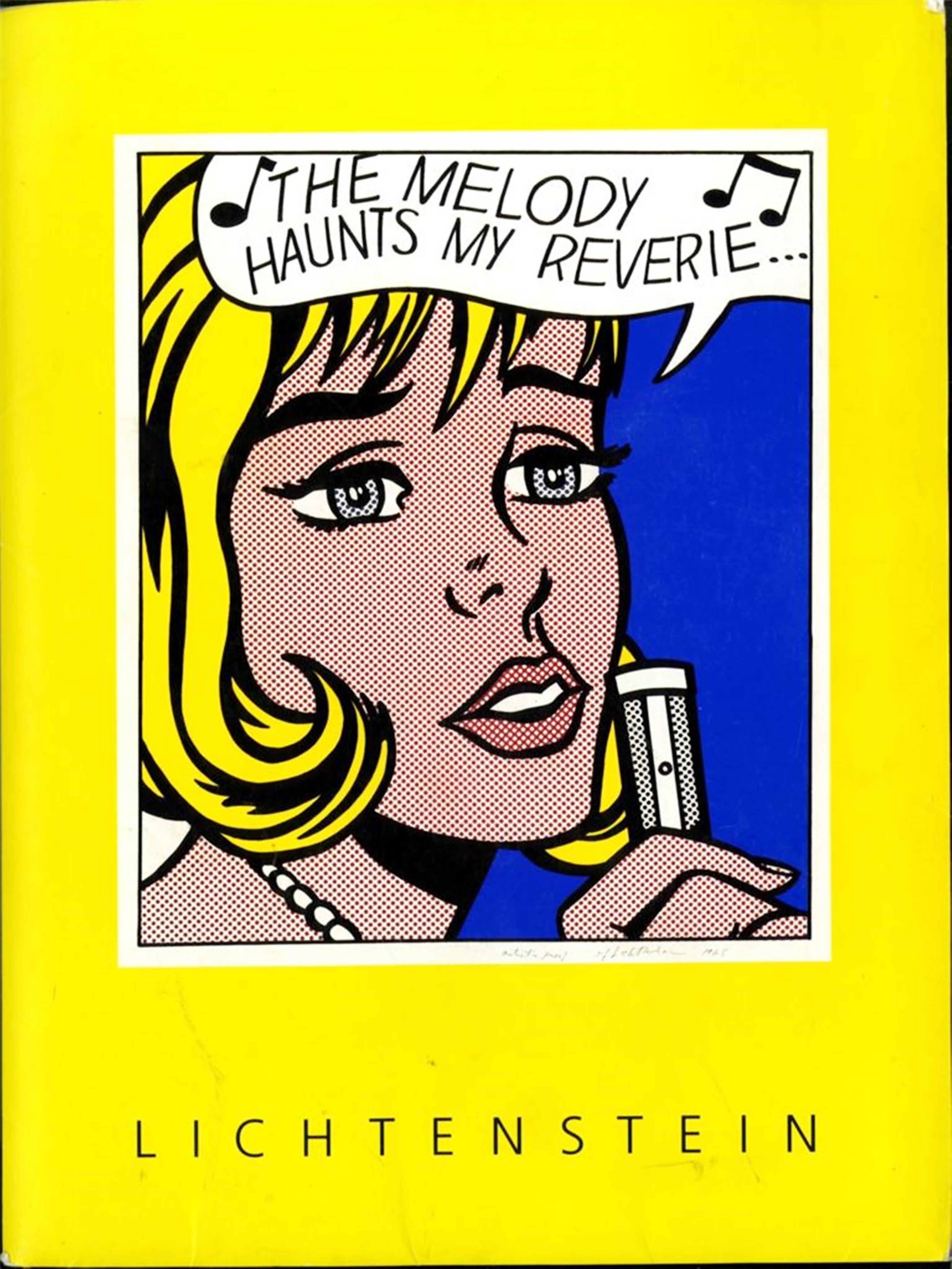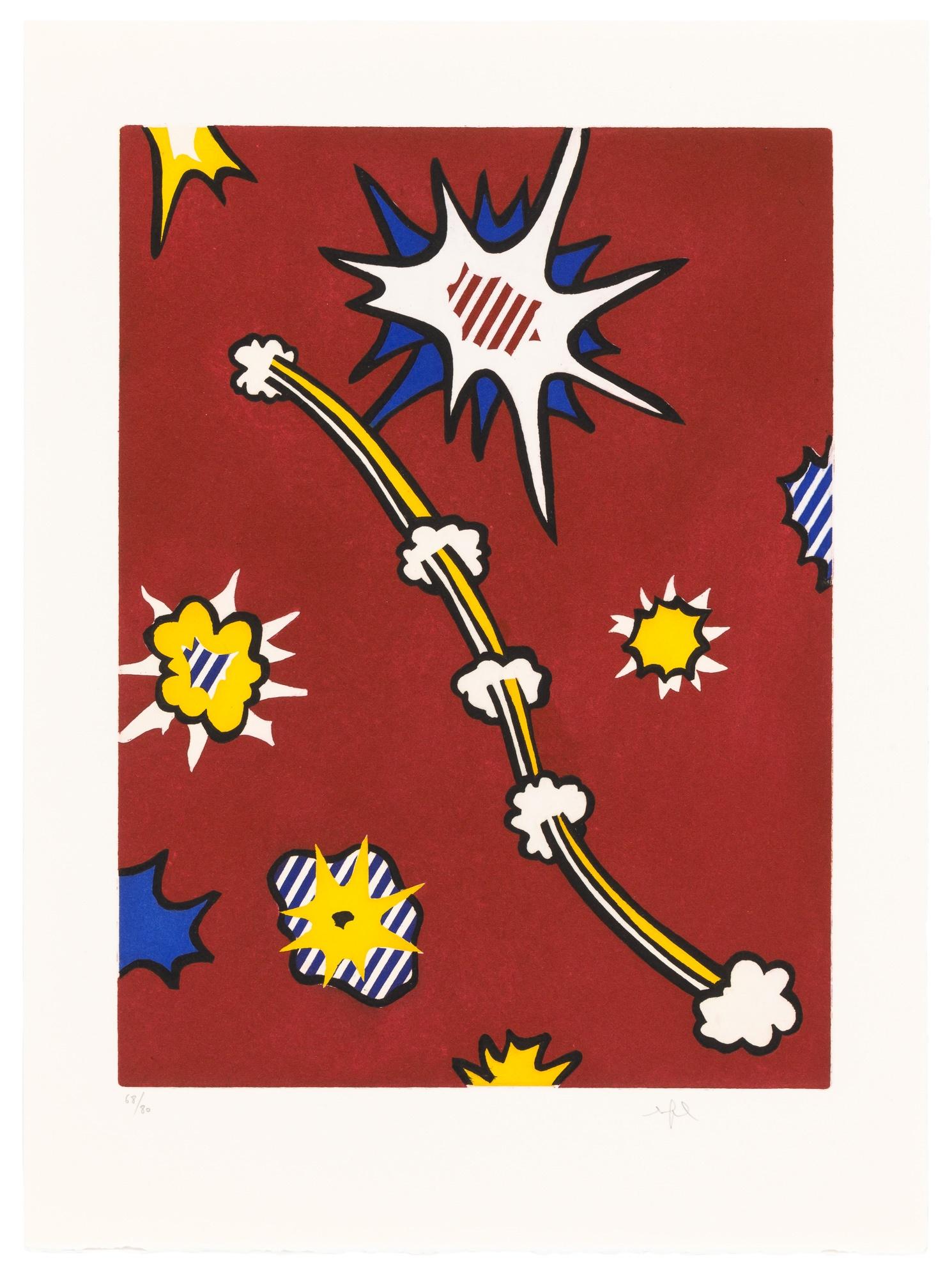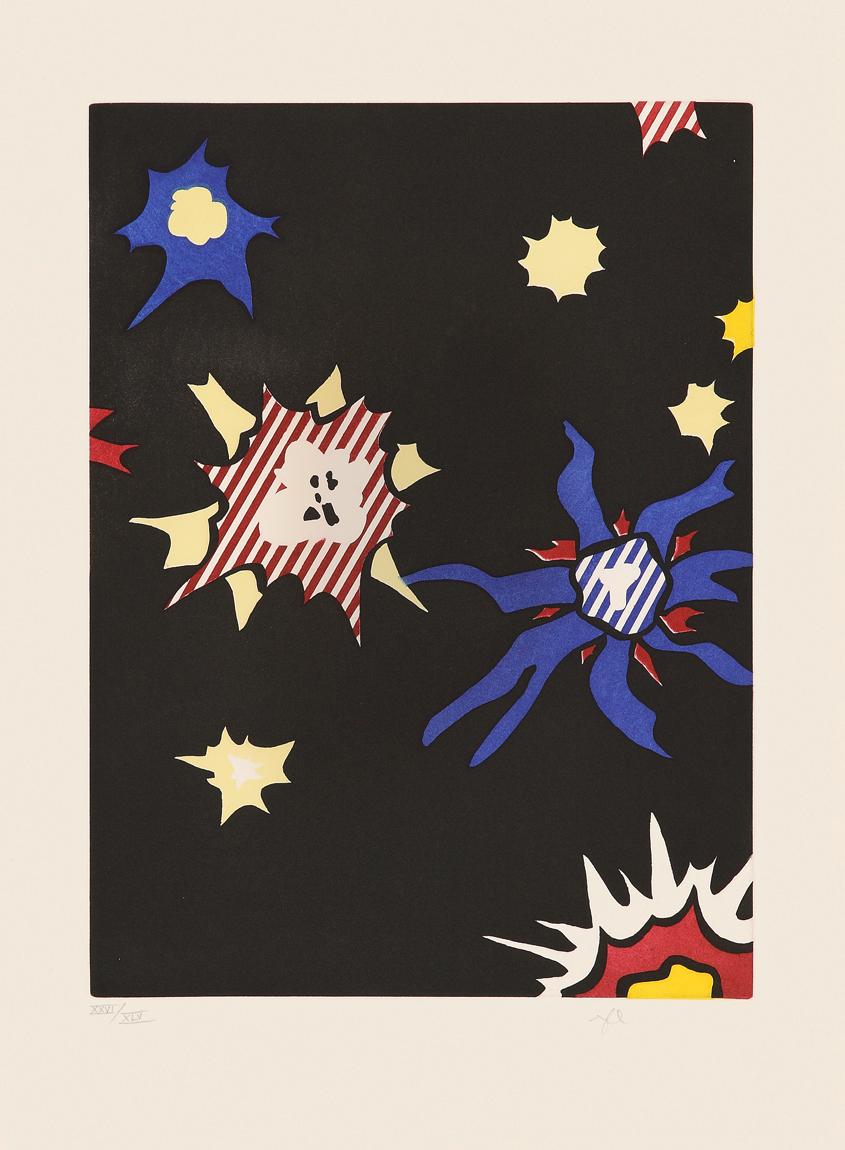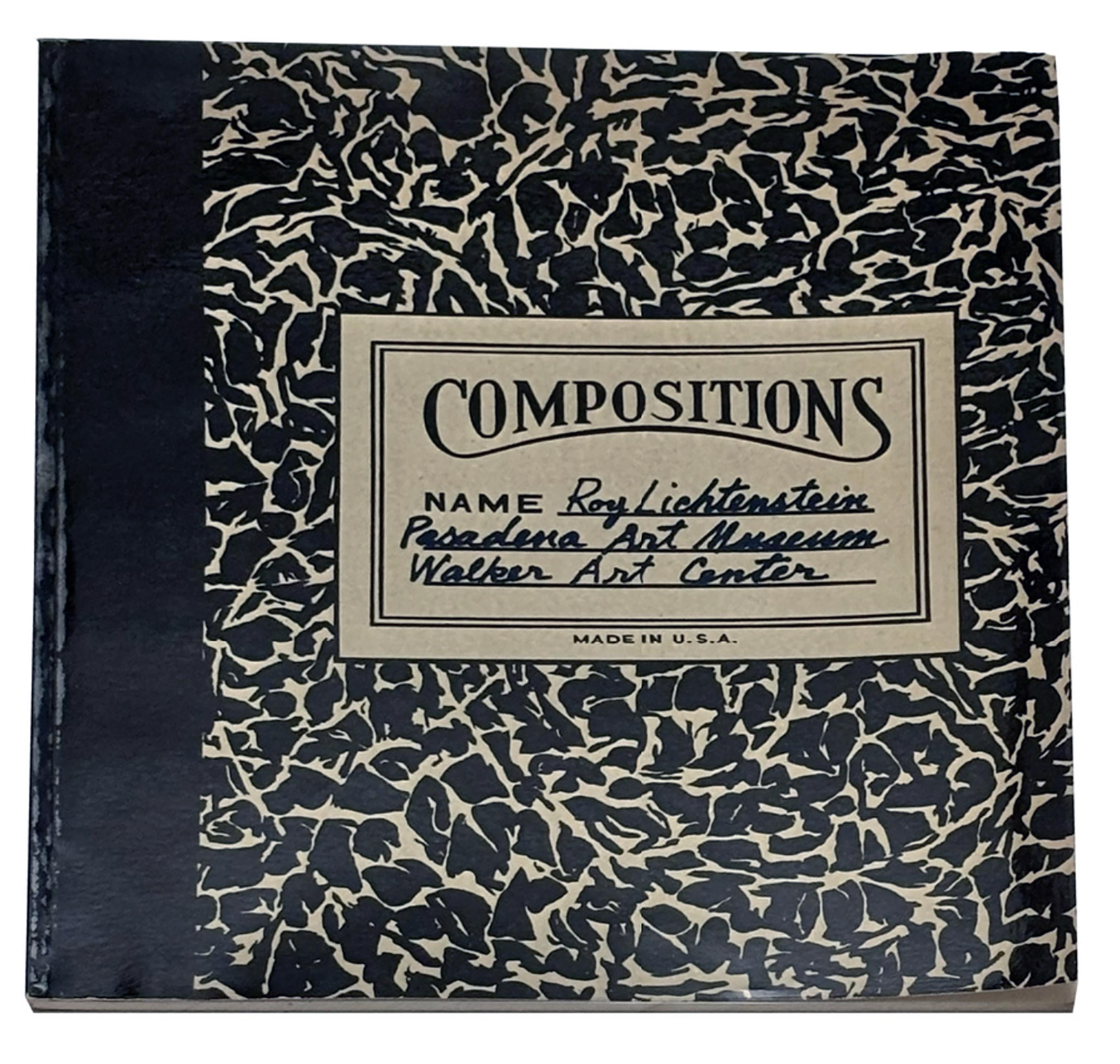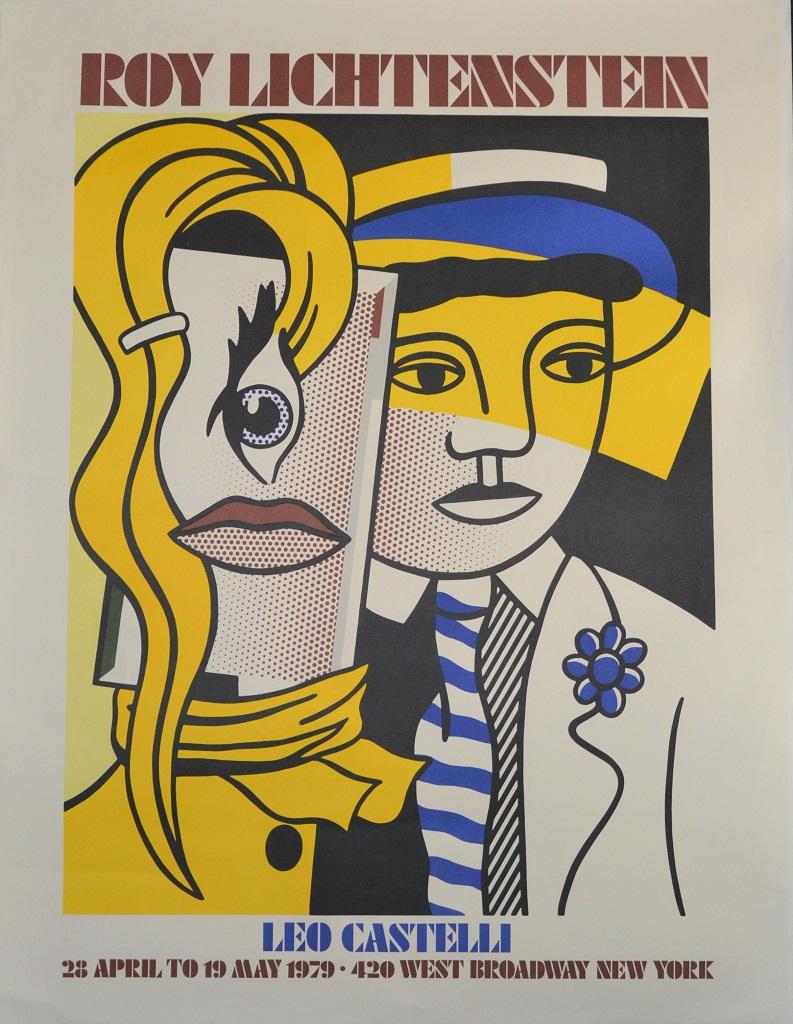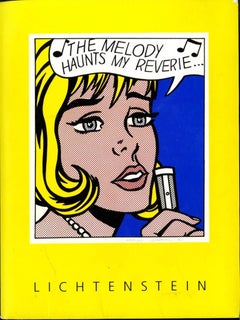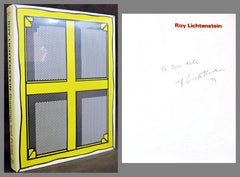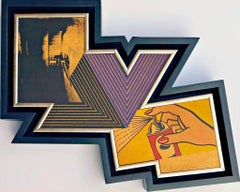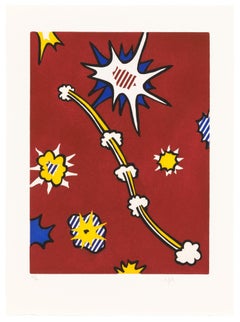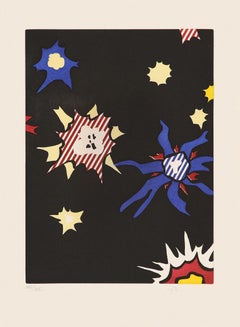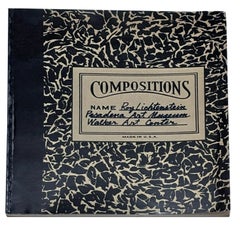Items Similar to Roy Lichtenstein at CSU, exhibition catalogue
Want more images or videos?
Request additional images or videos from the seller
1 of 10
Roy Lichtenstein at CSU, exhibition catalogue1982
1982
$800
£593.63
€691.50
CA$1,113.61
A$1,240.10
CHF 645.40
MX$15,290.29
NOK 8,219.71
SEK 7,725.73
DKK 5,159.44
Shipping
Retrieving quote...The 1stDibs Promise:
Authenticity Guarantee,
Money-Back Guarantee,
24-Hour Cancellation
About the Item
Roy Lichtenstein at CSU, exhibition catalogue, 1982
Softback exhibition catalogue with 2 very cool vellum pages with the Benday dots
Unsigned
11 × 8 1/2 inches
This softcover catalogue is unsigned and has no stated edition number, but it is extremely rare. Nobody else seems to have it. It comes with color and bw illustrations and 2 vellum pages with the Benday dots.
Published for the Roy Lichtenstein exhibition at Colorado State University from April 1 to 30, 1982.
About Roy Lichtenstein:
Pop Art looks out into the world. It doesn’t look like a painting of something, it looks like the thing itself.
—Roy Lichtenstein
Roy Fox Lichtenstein’s (1923–1997) high-impact, iconic paintings have become synonymous with Pop art—a movement he helped originate—and his merging of mechanical reproduction and hand drawing has become central to the critical understanding of the movement.
Born in New York, Lichtenstein developed an interest in drawing, science, and jazz music at a young age. He attended Ohio State University (1940–42), before being drafted into the Army (1943–45). Supported by the G.I. Bill following the war, Lichtenstein resumed his art studies at the School of Fine and Applied Arts at Ohio State and graduated with an MFA in 1949. He stayed in Ohio for the next eight years, working first as a teacher and later as an industrial draftsman and furniture designer, among other part-time roles. Lichtenstein then accepted an assistant professorship in industrial design at the State University of New York, Oswego, which led to a teaching position at Douglass College at Rutgers University, New Jersey.
In 1961 Lichtenstein painted one of his first Pop paintings, Look Mickey. This work, in its use of cartoon characters and deliberate imitation of the Ben-Day dot commercial printing process, marked a major turning point in his career. Lichtenstein had his first solo show with Leo Castelli in early 1962—which sold out before the opening—and another in 1963. After this commercial success with Castelli, he resigned from Rutgers in 1964 and moved to back New York to concentrate exclusively on his art. Into the next decade, he depicted stylized landscapes, consumer-product packaging, adaptations of paintings by famous artists, geometric elements from Art Deco design, parodies of Abstract Expressionism, and war scenes and explosions. Despite their immense variation in subject matter, all of these works underlined the contradictions of representing three dimensions on a flat surface.
The late 1960s saw Lichtenstein’s first museum surveys: in 1967 the Pasadena Art Museum initiated a traveling retrospective, in 1968 the Stedelijk Museum, Amsterdam, presented his first European retrospective, and in 1969 he had his first New York retrospective, at the Solomon R. Guggenheim Museum. He began living in Southampton, New York, in 1968, and in 1984 he acquired a studio loft in Manhattan; thereafter he would split his time between Southampton and Manhattan.
In the early 1970s Lichtenstein explored formal questions further with his abstract Mirrors (1969–79) and Entablatures (1970–76) series. From 1974 into the 1980s he probed another long-standing interest: the concept of artistic style. He produced paintings that reinterpreted the forms and techniques of classical architecture, Cubism, Futurism, Surrealism, and more. Lichtenstein continued to question the role of style, this time in consumer culture, in his 1990s series Interiors (1990–97), which included images of his own works as decorative elements in domestic settings. In his attempt to fully grasp and expose how the forms, materials, and methods of production had shaped the images of Western visual culture, Lichtenstein also explored other mediums such as polychromatic ceramic, aluminum, brass, and serigraphy. He experimented with printmaking as early as the late 1940s and completed several large-scale public sculptures, as well as a number of major murals.
Lichtenstein continued to refine his technique and expand his subject matter in his later work, turning to such unexpected themes as the painterly gesture, the female nude, and Chinese landscape painting. In 1995 he was awarded the National Medal of Arts in recognition of his contributions to American art.
Courtesy of Gagosian Gallery
- Creation Year:1982
- Dimensions:Height: 11 in (27.94 cm)Width: 8.5 in (21.59 cm)
- Medium:
- Movement & Style:
- After:Roy Lichtenstein (1923 - 1997, American)
- Period:
- Condition:Shelfwear to the covers but interior pages including the vellum ones are in very good condition.
- Gallery Location:New York, NY
- Reference Number:1stDibs: LU1745213629652
About the Seller
5.0
Platinum Seller
Premium sellers with a 4.7+ rating and 24-hour response times
Established in 2007
1stDibs seller since 2022
439 sales on 1stDibs
Typical response time: 2 hours
- ShippingRetrieving quote...Shipping from: New York, NY
- Return Policy
Authenticity Guarantee
In the unlikely event there’s an issue with an item’s authenticity, contact us within 1 year for a full refund. DetailsMoney-Back Guarantee
If your item is not as described, is damaged in transit, or does not arrive, contact us within 7 days for a full refund. Details24-Hour Cancellation
You have a 24-hour grace period in which to reconsider your purchase, with no questions asked.Vetted Professional Sellers
Our world-class sellers must adhere to strict standards for service and quality, maintaining the integrity of our listings.Price-Match Guarantee
If you find that a seller listed the same item for a lower price elsewhere, we’ll match it.Trusted Global Delivery
Our best-in-class carrier network provides specialized shipping options worldwide, including custom delivery.More From This Seller
View AllVintage Museum Press Kit (National Gallery, LACMA & Dallas Museum)
By Roy Lichtenstein
Located in New York, NY
Roy Lichtenstein (after)
Vintage Museum Press Kit (National Gallery, LACMA & Dallas Museum), 1994 -1995
Offset Lithograph brochures, press releases, magazines and a bookmark
Unsigned...
Category
1990s Pop Art More Art
Materials
Offset
Hardback monograph of drawings and prints autographed by artist
By Roy Lichtenstein
Located in New York, NY
Roy Lichtenstein (after)
Hardback monograph of drawings and prints autographed by artist, 1973
Hardback Monograph.
Hand signed, inscribed and dated...
Category
1970s Pop Art More Art
Materials
Offset
Richard Pettibone The Appropriation Warhol, Stella, Lichtenstein, Unique Signed
By Richard Pettibone
Located in New York, NY
Richard Pettibone
The Appropriation Print Andy Warhol, Frank Stella, Roy Lichtenstein, 1970
Silkscreen in colors on masonite board (unique variant on sculpted board)
Hand-signed by artist, Signed and dated on the front (see close up image)
Bespoke frame Included
This example of Pettibone's iconic Appropriation Print is silkscreened on masonite board rather than paper, giving it a different background hue, and enabling it work to be framed so uniquely.
The Appropriation print is one of the most coveted prints Pettibone ever created ; the regular edition is on a full sheet with white background; the present example was silkscreened on board, allowing it to be framed in 3-D. While we do not know how many examples of this graphic work Pettibone created, so far the present work is the only one example we have ever seen on the public market since 1970. (Other editions of The Appropriation Print have been printed on vellum, wove paper and pink and yellow paper.)
This 1970 homage to Andy Warhol, Frank Stella and Roy Lichtenstein exemplifies the type of artistic appropriation he was engaging in early on during the height of the Pop Art movement - long before more contemporary artists like Deborah Kass, Louise Lawler, etc. followed suit.
This silkscreen was in its original 1970 vintage period frame; a bespoke custom hand cut black wood outer frame was subsequently created especially to house the work, giving it a distinctive sculptural aesthetic.
Measurements:
Framed 14.5 inches vertical by 18 inches horizontal by 2 inches
Work
13 inches vertical by 16.5 inches horizontal
Richard Pettibone biography:
Richard Pettibone (American, b.1938) is one of the pioneering artists to use appropriation techniques. Pettibone was born in Los Angeles, and first worked with shadow boxes and assemblages, illustrating his interest in craft, construction, and working in miniature scales. In 1964, he created the first of his appropriated pieces, two tiny painted “replicas” of the iconic Campbell’s soup cans by Andy Warhol (American, 1928–1987). By 1965, he had created several “replicas” of paintings by American artists, such as Warhol, Roy Lichtenstein (1923–1997), Ed Ruscha (b.1937), and others, among them some of the biggest names in Pop Art. Pettibone chose to recreate the work of leading avant-garde artists whose careers were often centered on themes of replication themselves, further lending irony to his work. Pettibone also created both miniature and life-sized sculptural works, including an exact copy of Bicycle Wheel by Marcel Duchamp (French, 1887–1968), and in the 1980s, an entire series of sculptures of varying sizes replicating the most famous works of Constantin Brancusi (Romanian, 1876–1957). In more recent years, Pettibone has created paintings based on the covers of poetry books by Ezra Pound, as well as sculptures drawn from the grid compositions of Piet Mondrian (Dutch, 1872–1944). Pettibone straddles the lines of appropriation, Pop, and Conceptual Art, and has received critical attention for decades for the important questions his work raises about authorship, craftsmanship, and the original in art. His work has been exhibited at the Institute for Contemporary Art in Philadelphia, the Museum of Modern Art in New York, the Museum of Contemporary Art in Miami, and the Laguna Art Museum in Laguna Beach, CA. Pettibone is currently based in New York.
"I wished I had stuck with the idea of just painting the same
painting like the soup can and never painting another painting.
When someone wanted one, you would just do another one.
Does anybody do that now?"
Andy Warhol, 1981
Since the mid-1960s, Richard Pettibone has been making
hand-painted, small-scale copies of works by other artists — a
practice due to which he is best known as a precursor of appropriation art — and for a decade now, he has been revisiting subjects from across his career. In his latest exhibitions at
Castelli Gallery, Pettibone has been showing more of the “same”
paintings that had already been part of his 2005–6 museum retrospective,1
and also including “new” subject matter drawn from
his usual roster of European modernists and American postwar
artists. Art critic Kim Levin laid out some phases of the intricate spectrum from copies to repetitions in her review of the
Warhol-de Chirico showdown, a joint exhibition at the heyday
of appropriation art in the mid-1980s when Warhol’s appropriations of de Chirico’s work effectively revaluated “the grand
old auto-appropriator”.
Upon having counted well over a dozen
Disquieting Muses by de Chirico, Levin speculated: “Maybe he
kept doing them because no one got the point. Maybe he needed the money. Maybe he meant it when he said his technique
had improved, and traditional skills were what mattered.”
On
the other side, Warhol, in her eyes, was the “latter-day exemplar
of museless creativity”.
To Pettibone, traditional skills certainly
still matter, as he practices his contemporary version of museless creativity. He paints the same painting again and again,
no matter whether anybody shows an interest in it or not. His
work, of course, takes place well outside the historical framework of what Levin aptly referred to as the “modern/postmodern wrestling match”,
but neither was this exactly his match
to begin with.
Pettibone is one of appropriation art’s trailblazers, but his diverse
selection of sources removes from his work the critique of the
modernist myth of originality most commonly associated with
appropriation art in a narrow sense, as we see, for example, in
Sherrie Levine’s practice of re-photographing the work of Walker
Evans and Edward Weston. In particular, during his photorealist
phase of the 1970s, Pettibone’s sources ranged widely across
several art-historical periods. His appropriations of the 1980s
and 1990s spanned from Picasso etchings and Brancusi sculptures to Shaker furniture and even included Ezra Pound’s poetry.
Pettibone has professed outright admiration for his source artists, whose work he shrinks and tweaks to comic effect but, nevertheless, always treats with reverence and care. His response
to these artists is primarily on an aesthetic level, owing much
to the fact that his process relies on photographs. By the same
token, the aesthetic that attracts him is a graphic one that lends
itself to reproduction. Painstakingly copying other artists’ work by hand has been a way of making
it his own, yet each source is acknowledged in
his titles and, occasionally, in captions on white
margins that he leaves around the image as an
indication that the actual source is a photographic image. The enjoyment he receives in copying
is part of the motivation behind doing it, as is
the pleasure he receives from actually being with
the finished painting — a considerable private
dimension of his work. His copies are “handmade
readymades” that he meticulously paints in great quantities in his studio upstate in New York; the commitment
to manual labor and the time spent at material production has
become an increasingly important dimension of his recent work.
Pettibone operates at some remove from the contemporary art
scene, not only by staying put geographically, but also by refusing to recoup the simulated lack of originality through the
creation of a public persona.
In so doing, Pettibone takes a real
risk. He places himself in opposition to conceptualism, and he is
apprehensive of an understanding of art as the mere illustration
of an idea. His reading of Marcel Duchamp’s works as beautiful
is revealing about Pettibone’s priorities in this respect.
When
Pettibone, for aesthetic pleasure, paints Duchamp’s Poster for
the Third French Chess...
Category
1970s Pop Art Abstract Prints
Materials
Masonite, Pencil, Screen
Ileana and Michael Sonnabend Collection: Princeton University Art Museum poster
By Roy Lichtenstein
Located in New York, NY
Roy Lichtenstein (after)
Eddie Diptych: Selections from the Ileana and Michael Sonnabend Collection, Princeton University Art Museum poster, 1985
Off...
Category
1980s Pop Art Figurative Prints
Materials
Offset
Pop Art Appropriation Print: Andy Warhol, Frank Stella, Roy Lichtenstein, SIGNED
By Richard Pettibone
Located in New York, NY
Richard Pettibone
The Appropriation Print: Andy Warhol, Frank Stella, Roy Lichtenstein, 1970
(Andy Warhol's Electric Chair, Frank Stella's Empress of India and Roy Lichtenstein's Spray)
Silkscreen in colors on smooth wove paper
Pencil signed and dated 1971 on the front
Frame included:
Elegantly floated and framed in a white wood frame under UV plexiglass in accordance with museum conservation standards
Measurements:
frame: 15 7/8 x 19 3/4 x 1 3/4 inches
sheet: 12 1/4 x 16 inches
This is one of Richard Pettibone's most iconic, popular and desirable prints done in 1970 - during the most influential era of the Pop Art movement. This homage to Andy Warhol, Frank Stella and Roy Lichtenstein exemplifies the type of artistic appropriation he was engaging in early on during the height of the Pop Art movement - long before more contemporary artists like Deborah Kass, Louise Lawler, etc. followed suit. Pencil signed and dated recto. It was created in limited edition - though the exact number is not known.
More about RIchard Pettibone:
As a young painter, Richard Pettibone began replicating on a miniature scale works by newly famous artists, and later also modernist masters, signing the original artist’s name as well as his own. His versions of Andy Warhol’s soup...
Category
1970s Pop Art Abstract Prints
Materials
Screen, Pencil
The Red Horsemen Modern Art Pavilion Lt Ed Seattle Art Museum print
By Roy Lichtenstein
Located in New York, NY
Roy Lichtenstein at Modern Art Pavilion, Seattle Art Museum Limited Edition poster, 1976
Offset lithograph
Limited Edition of 1000
22 1/2 × 28 inches
Unframed, unsigned
Publisher
Se...
Category
1970s Pop Art Abstract Prints
Materials
Offset
You May Also Like
Lichtenstein De Denver au Montana, Départ 27 Mai (II) Signed New Fall of America
By Roy Lichtenstein
Located in Philadelphia, PA
Roy Lichtenstein
Illustration for ‘De Denver au Montana, Départ 27 Mai 1972” (II), From ‘La Nouvelle Chute de l’Amérique (The New Fall of America)”
Etching and aquatint on 250-gram ...
Category
Late 20th Century Pop Art Prints and Multiples
Materials
Etching
Roy Lichtenstein (1923-1997) - Explosion - Lithograph on Rives paper - 1967
By Roy Lichtenstein
Located in Varese, IT
Lithograph on Rives paper, edited in 1967
Limited edition of 100 copies
Signed in pencil by artist and numbered: 41/100
paper size: : 56 x 43.1 cm
framed size: 65 x 51 cm
very good ...
Category
1960s Abstract Prints and Multiples
Materials
Lithograph
Illustration for "Hüm Bum!" from "La Nouvelle Chute de l'Amérique" - Pop Art
By Roy Lichtenstein
Located in Köln, DE
This etching and aquatint in colours from 1992 was published in ‘La Nouvelle Chute de l'Amérique’ (The New Fall of America). The 115-page unbound book comprises 11 poems by Allen Gin...
Category
1990s Pop Art Prints and Multiples
Materials
Etching, Aquatint
Signed Roy Lichtenstein Compositions catalog 1967
By Roy Lichtenstein
Located in NEW YORK, NY
Autographed Roy Lichtenstein Compositions exhibition catalog 1967:
A must have hand-signed & dedicated example, with brilliant cover desi...
Category
1960s Pop Art More Art
Materials
Offset
Roy Lichtenstein for Leo Castelli Gallery - Offset after Roy Lichtenstein - 1979
By Roy Lichtenstein
Located in Roma, IT
Roy Lichtenstein for Leo Castelli Gallery is a very colorful artwork realized after Roy Lichtenstein in 1979.
Mixed colored offset on paper.
This beautiful print was realized on t...
Category
1980s Pop Art More Prints
Materials
Offset
$1,083 Sale Price
25% Off
Roy Lichtenstein 'Okay, Hot-Shot!' Vintage 1988
By Roy Lichtenstein
Located in Brooklyn, NY
This offset lithograph, OK Hot Shot, is part of a now out-of-print six-print portfolio published by the Guggenheim Museum, highlighting Roy Lichtenstein’s signature Pop Art aesthetic...
Category
1980s Pop Art Prints and Multiples
Materials
Offset
More Ways To Browse
Jazz Age Art
Painted Pop Art Furniture
Pop Art Prints Roy Lichtenstein
Lichtenstein Studio
Lichtenstein Lithograph
Ben Day
Art Deco Murals
Fox Ceramic
Leo Castelli Lithograph
G Roy Art
1970s Printed Mirror
Art Deco Furniture By Jazz
Retro Futurism Painting
Vintage Furniture Southampton
Vintage Ceramic Fox
1980 Art Deco Mirror
42 Inch Mirror
Ben Day Dots
